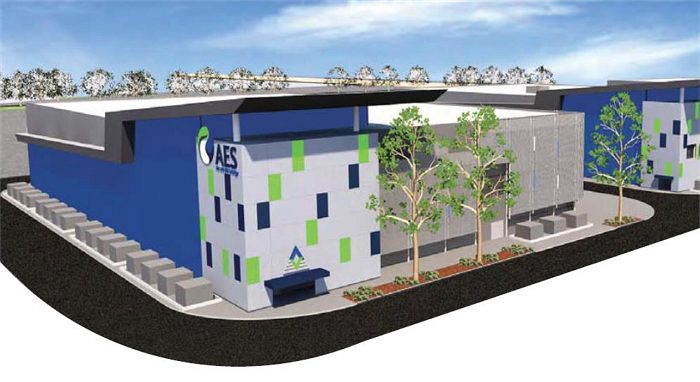
The company that held the title of the world’s largest installed lithium-ion battery system earlier this year has cleared a hurdle for a far larger energy storage project.
In California, City of Long Beach councillors reportedly voted unanimously last week to deny a challenge relating to the development of a 300MW battery system near the Los Cerritos Wetlands, to be constructed by AES.
The project involves three 20-metre-high, 4,134 square-metre buildings that will house the monster battery system at the Alamitos Generating Station; a gas fired power plant. A large centralized chiller plant will also be constructed, to be used as a cooling system for the energy storage facility. The rooftops of the buildings have been designed to accommodate solar panels at a later date.
The battery system will not be connected to the station’s power generation units, but to the regional mains grid via a Southern California Edison switchyard located on an adjacent property. The facility will enable Southern California Edison to store energy during periods of surplus supply and discharge it during times of high demand.
“Due to the increase of regionwide solar electricity usage, coupled with an increase in consumer electronic usage, the daytime demand on power plants has decreased, while the evening hours have increased,” says a City of Long Beach document.
The project required special permissions given the height of the buildings and its general nature. However, it did not need a full environmental impact report due to a Mitigated Negative Declaration 1. This was an issue of concern to some in the local community that resulted in the challenge and a demand for a full report process. Safety was another concern raised by some residents of the area.
Construction is proposed to commence in 2019, with the first building scheduled to be completed in 2020 and the final building finished in 2023. Given the timeframes involved and the increasing pace of large-scale lithium-ion battery storage rollouts globally, it may be that by the time the project is completed, another “worlds-largest” system may have been installed eclipsing this system.
AES says it operates the world’s largest fleet of battery-based storage assets currently in service.
“AES Energy Storage has a total of 476 MW of interconnected energy storage, equivalent to 952 MW of flexible resource, in operation, construction or late stage development across seven countries and four continents,” states the company.
While AES was unsuccessful in its bid for South Australia’s major battery project, the company stated in August it was in discussions with several state governments about large-scale battery systems.
In July this year, AES also joined forces with Siemens to create Fluence, a new energy storage company.
“Fluence will accelerate energy storage technology, increase network flexibility and stability, and enable the seamless energy transformation for customers as we build the new energy network of the future.”
Fluence will operate independently of its parent companies.
Footnotes
- A Mitigated Negative Declaration is a document that acknowledges an initial study may have revealed some potential significant environmental effects, but project revisions that are described and will be implemented mitigate those potential effects ↩

 RSS - Posts
RSS - Posts



Speak Your Mind